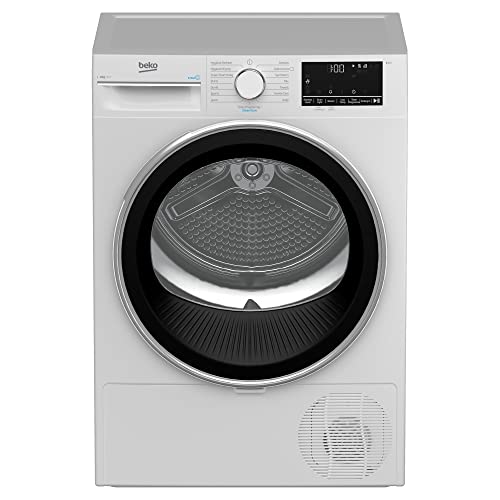14 Businesses Are Doing A Fantastic Job At Tumble Dryers Heat Pump

Tumble Dryers Heat Pump
Tumble dryers with heat pump make use of clever technology to make them energy efficient gentle on fabrics and economical in the long term. Because they don't need a vent, like condenser and vented models, you can place them anywhere in your home.
The benefits of tumble dryers equipped with heat pumps far outweigh the slight disadvantages.
Energy efficiency
The clothes dryers that use heat pump are designed to recycle energy instead of using it to create it. The technology is similar to a fridge, however the insides are reversed. Rather than producing heat using a heating element, refrigerants absorb warmth from the air outside and then pumps it into the drum with wet clothes. When the refrigerant has reached an unsatisfactory temperature, it extracts the moisture from the warm air and then releases it into a drain or storage tank. The warm air, and then transports the humidity back into tumble cycles, using less power.
The lower maximum temperatures of heat pump dryers mean they're more gentle on clothes, too, and prevent excess wear and shrinkage. They use less electricity and can save families with large electric bills hundreds of dollars per year.
A family in the US is able to do 20 loads of laundry each week. The savings could be significant. A heat-pump dryer can cut costs by as much as a third according to the Massachusetts Clean Energy Center, which is among the most prominent energy efficiency advocates.
You can also reduce your energy bills by not overloading your tumble dryer. The machine will perform better when you keep your laundry load to a minimum. It will also allow it to complete the process as fast as possible without compromising on quality.
Tumble dryers equipped with heat pump technology consume 3 times less energy than conventional air-ventilated clothes dryers. They also meet the new Energy labelling and Ecodesign requirements that will be in effect beginning in July 2025. These requirements are designed to help European households save up to 15 TWh of energy by 2040.
Other methods to reduce energy consumption include keeping the dryer in a well-insulated room, making sure the duct for ventilation isn't blocked and making sure it's regularly cleaned of lint, which could cause the tumble dryer to run up your electric bill and cause dangers to your health and safety. Manufacturers might have different guidelines on how often to clean the lint filter and the fine mesh screen. However, ensuring that the dryer is running at maximum efficiency is essential.
Moisture extraction
These tumble dryers with heat pumps are very like traditional vented models, with the exception that they don't need vents for moisture extraction. Instead the hot air used to dry your clothes is used again in conjunction with the moisture that is collected in the water tank. This can cut down on your energy usage and help you save money on your utility bill.
There are some things to keep in mind when using heat pump tumble dryers. These models take a little longer to dry due to lower temperatures. The water tank should be cleaned regularly, and ideally every time you complete a load. You can either drain the tank into a sink or washbasin nearby, or manually empty the water into an integrated tank. The humidity of your home can also affect the frequency you must empty the tank.

Another thing to be aware of is that these dryers may create a small amount condensation on the exterior of the dryer. This is normal and can be slowed down by wiping the coils clean frequently. Additionally, there might be an unpleasant smell in the area when your laundry is being dried, which can be overcome by opening a window.
When a vented dryer is in operation, it makes use of resistance heating elements to warm the air before dumping this hot, moist air into the atmosphere through a duct. This air is then returned to the home which is then heated by your central heating system. However, heat pump technology reuses this hot air. The moisture collected by the machine is later stored in a separate water tank.
The air in your house that is blown out is replaced by colder air from outside. This allows the dryer to operate at less temperature, without causing any harm to your clothing. This is one of the main reasons that these dryers are so much more efficient than condenser models vented or vented.
Another benefit of this technology is that it can aid in reducing the dependence on power sources from outside, and it is not dependent on a gas supply for its energy. This is a great option if you live in an isolated region or don't want rely on electric power.
Versatility
The tumble dryers that use heat pump technology use the energy they produce to dry clothes. They are not just more environmentally sustainable, but they are also less expensive.
The savings you make on utility bills can quickly pay off the initial cost of a few models. Heat pump tumble dryers are an excellent long-term investment, especially for households who are committed to reducing their expenses and the environment.
The AEG Heat Pump H-DRY 500 Hoover Direct is an excellent example of a tumbler made by a heat pump dryer that has high-end features. It comes with a 9kg drum size that'll easily accommodate larger families and the Aenergy efficiency rating of ++ will keep your energy usage in the right place. It can detect and automatically alter the duration of the wash cycle based upon your water's mineral content to further reduce energy usage.
Sensor drying and an infant lock are two other important features. The dryer will stop when your clothes are dry to wear. The efficient tumble action uses less air than a traditional tumble dryer, which means that your laundry gets done faster. The dryer is easy to clean and maintain as it has a purse filter.
The Indesit NIS41VUK is a low-cost tumble dryer that prioritizes the affordability without sacrificing function or eco credentials. It is able to hold 4kg and 13 versatile programs that can be used with all fabrics. It can be used with an external vent, which is ideal for smaller homes and apartments. It's not equipped with all the features you'd find in higher-end models, such as final dry or cool tumble sensor however it does include everything you need to get the job done.
Noise
The models with heat pumps are quieter than vented tumble dryers. heat-pump tumble dryer is because of a system to reduce vibrations, insulation and an inverter.
The dryers also run at lower temperatures which means your laundry is less likely to be over-dried and damaged. This means that they will take a little longer to finish their cycle, but this is offset by lower energy consumption and lower operating costs.
A loud tumble dryer is an indication that something isn't right. An appliance repair technician should investigate this. The most frequent sounds that a tumble dryer can make include a rumbling, banging, scraping and the sound of rumbling.
A squeaking noise from your tumble dryer will probably suggest that the drum pivot bearing is worn out and must be replaced. A misshaped support wheel is often the reason for a rumbling noise, while the constant scraping is a sign of damaged jockey wheel that pulls the drive belt.
If your tumble dryer is new or hasn't used for a while it might make a rumbling noise in the initial few minutes of operation. This is normal and occurs because the machine's wheels lubricate, but if it continues to occur for longer than this please call us for advice.
Tumble dryers can be complicated machines that are designed to be reliable, but they still have problems. If you find that yours is making a loud and annoying whistling sound, it's important to act quickly to avoid any more damage or expensive repair bills. It could be due to one of the causes mentioned above, or it may be an electrical fault that requires investigation by an experienced appliance electrician. Leaving it to get worse could lead to higher repair costs and may even damage your clothing.
